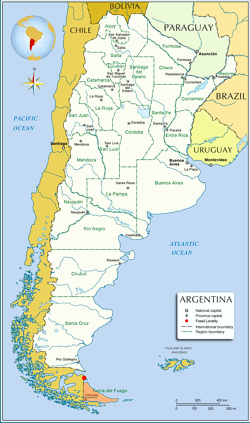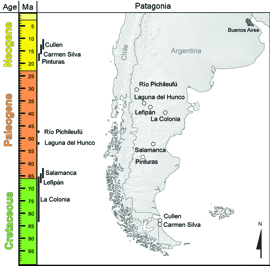 The most important outcrops of the Carmen Silva Formation from the paleobotanical point of view are found in the cliffs of the San Sebastián Bay, in the NE Atlantic coast of the Isla Grande de Tierra del Fuego. Invertebrate biostratigraphic studies indicate a possible Miocene age and a possible delta front/prodelta for the paleoenvironment.
The most important outcrops of the Carmen Silva Formation from the paleobotanical point of view are found in the cliffs of the San Sebastián Bay, in the NE Atlantic coast of the Isla Grande de Tierra del Fuego. Invertebrate biostratigraphic studies indicate a possible Miocene age and a possible delta front/prodelta for the paleoenvironment.
These deposits have an interesting history dating back to the voyages of Darwin who registered his passage through the San Sebastián Bay and noted the presence of strata with "leaves of trees." The first paleobotanical collections of the island of Tierra del Fuego were made by members of two Swedish expeditions (Swedish Expeditions to Magellaneslandern Expedition 1895-1897 and Swedish Southpolar 1901-1903) and are deposited at the Swedish Museum, Stockholm. The fossils came precisely from the outcrops of the Carmen Silva and Cullen formations.
In 1907, Dusén published the first descriptions of Tertiary plant macrofossils collected during these expeditions. Much later, Romero and Dibbern (1985) reviewed and re-described the fossils assigned to “Fagaceae” from those collections. In summary, little is known about these paleofloras, except for those referred to Nothofagus.
M. A. Gandolfo and M. C. Zamaloa rediscovered this site in the early 90s and they found it to be rich in angiosperm leaves, while the preliminary palynology would indicate some fertile levels dominated by Nothofagus. Carmen Silva’s deposits are currently being studied within an integrated approach with the Cullen Formation.
Lab Work
Much of the detailed work involved in describing and understanding species of fossil plants takes place in the lab. We employ many traditional methods of paleobotanical study, such as making observations, describing fossil species, and comparing fossil species to living plants, in order to understand the plants that we find in the field. In addition, we use modern analytical techniques to attempt to gain a more precise understanding of the evolutionary relationships of fossil and living plants.
Other Paleofloras
(Youngest-Oldest)
- Cenozoic Paleofloras
- Cullen (middle Miocene)
- Carmen Silva (Miocene)
- Pinturas (late-early Miocene)
- Río Pichileufú (early-middle Eocene)
- Laguna del Hunco (Early Eocene)
- Salamanca (early Paleocene)
- Cretaceous Paleofloras
- Lefipán (Maastrichtian- 65.5-66 myo)
- La Colonia (Campanian to Maastrichtian)
